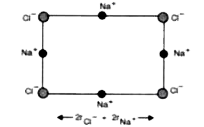Formula mass of NaCl is 58.45gmol−1 and density of its pure form is 2.167gcm−3. The average distance between adjacent sodium and chloride ions in the crystal is 2.814×10−8cm. Calculate Avogadro constant.
To calculate Avogadro's constant using the given data for NaCl, we can follow these steps:
Step 1: Understand the relationship between density, mass, and volume
The density (D) of a substance is given by the formula:
D=mV
where m is the mass and V is the volume.
Step 2: Identify the number of formula units in the unit cell
For NaCl, which crystallizes in a face-centered cubic (FCC) lattice, the number of formula units (Z) per unit cell is 4.
Step 3: Use the formula for density in terms of Avogadro's number
The density can also be expressed as:
D=Z⋅MNA⋅A3
where:
- M is the molar mass (58.45 g/mol for NaCl),
- NA is Avogadro's number,
- A is the edge length of the unit cell.
Step 4: Calculate the edge length (A) from the given distance
The average distance between adjacent sodium and chloride ions is given as 2.814×10−8 cm. In an FCC lattice, this distance corresponds to:
A=2×(distance between ions)=2×2.814×10−8 cm=5.628×10−8 cm
Step 5: Calculate the volume of the unit cell
The volume V of the cubic unit cell is given by:
V=A3=(5.628×10−8 cm)3
Calculating A3:
V=(5.628×10−8)3=1.786×10−23 cm3
Step 6: Rearranging the density formula to find NA
Substituting the known values into the density formula:
D=Z⋅MNA⋅A3
Rearranging for NA:
NA=Z⋅MD⋅A3
Step 7: Substitute the known values
Substituting the values:
- Z=4
- M=58.45 g/mol
- D=2.167 g/cm3
- A3=1.786×10−23 cm3
NA=4⋅58.452.167⋅1.786×10−23
Step 8: Calculate NA
Calculating the numerator:
4⋅58.45=233.8
Calculating the denominator:
2.167⋅1.786×10−23=3.867×10−23
Now substituting these into the equation:
NA=233.83.867×10−23≈6.05×1023 mol−1
Final Result
Thus, the calculated value of Avogadro's constant is approximately:
NA≈6.05×1023 mol−1
---
The density (D) of a substance is given by the formula:
D=mV
where m is the mass and V is the volume.
For NaCl, which crystallizes in a face-centered cubic (FCC) lattice, the number of formula units (Z) per unit cell is 4.
The density can also be expressed as:
D=Z⋅MNA⋅A3
where:
- M is the molar mass (58.45 g/mol for NaCl),
- NA is Avogadro's number,
- A is the edge length of the unit cell.
The average distance between adjacent sodium and chloride ions is given as 2.814×10−8 cm. In an FCC lattice, this distance corresponds to:
A=2×(distance between ions)=2×2.814×10−8 cm=5.628×10−8 cm
The volume V of the cubic unit cell is given by:
V=A3=(5.628×10−8 cm)3
V=(5.628×10−8)3=1.786×10−23 cm3
Substituting the known values into the density formula:
D=Z⋅MNA⋅A3
NA=Z⋅MD⋅A3
Substituting the values:
- Z=4
- M=58.45 g/mol
- D=2.167 g/cm3
- A3=1.786×10−23 cm3
Calculating the numerator:
4⋅58.45=233.8
2.167⋅1.786×10−23=3.867×10−23
NA=233.83.867×10−23≈6.05×1023 mol−1
Thus, the calculated value of Avogadro's constant is approximately:
NA≈6.05×1023 mol−1
Topper's Solved these Questions
- BOOK - AAKASH INSTITUTE ENGLISHCHAPTER - THE SOLID STATE EXERCISE - ASSIGNMENT SECTION-A (OBJECTIVE)50videos
THE SOLID STATE
- BOOK - AAKASH INSTITUTE ENGLISHCHAPTER - THE SOLID STATE EXERCISE - ASSIGNMENT SECTION-B (OBJECTIVE)27videos
THE SOLID STATE
- BOOK - AAKASH INSTITUTE ENGLISHCHAPTER - THE SOLID STATE EXERCISE - Assignment (SECTION - D) (ASSERTION-REASON TYPE QUESTION)20videos
THE SOLID STATE
- BOOK - AAKASH INSTITUTE ENGLISHCHAPTER - THE S-BLOCK ELEMENTSEXERCISE - Assignment (Section-J)10videos
THE S-BLOCK ELEMENTS
- BOOK - AAKASH INSTITUTE ENGLISHCHAPTER - THERMODYNAMICSEXERCISE - ASSIGNMENT (Section -D) Assertion-Reason Type Questions15videos
THERMODYNAMICS
Similar Questions
Potassium fluoride (KF) has NaCl structure . Its density is 2.48gcm−3 and its molar mass is 58gmol−1. Compute the distance between K+ and F−ions∈KF.
View SolutionWhat is the distance between Na+ and Cl− ions in NaCl crystal if its density is 2.165g cm−3 ? NaCl crystallizes in fcc lattice.
 View Solution
View Solution
Knowledge Check
- Question 1 - Select One
The distance between Na+ and Cl− ions in NaCl with a density 3.165gcm−3 is
A497 pmB248.5 pmC234 pmD538.5 pm - Question 2 - Select One
The density of crystalline CsCl is 3.988g/cm3. The volume effectively occupied by a single CsCl ion pairs in the crystals is :(Given CsCl has mol. Mass 168.4)
A7.014×10−3cm3B7.014×10−23cm3C1.014×10−3cm3D1.542×10−5cm3 - Question 3 - Select One
An element with density 2.8 g cm−3 forms a fee unit cell with edge length 4×10−8 cm. Calculate the molar mass of the element.
A42gmol−1B27gmol−1C36gmol−1D28gmol−1
The density of an ideal gas is 1.25×10−3gcm−3 at STP. Calculate the molecular weight of the gas.
View SolutionThe dissoctiation of water of 25∘C is 1.9×10−7% and the density of water is 1g/cm3 the ionisation constant of water is
View SolutionKF has NaCl structure. What is the distance between K+ and F− in KF, if the density is 1.5gcm−3?
View SolutionCsCl has cubic structure. Its density is 3.99gcm−3. What is the distance between Cs⊕ and ClΘ ions?
(Atomic mass of Cs=133)View SolutionAn element with density 11.2g cm−3 forms a fcc lattice with edge length of 4×10−8 cm. Calculate the atomic mass of the element.
View Solution

